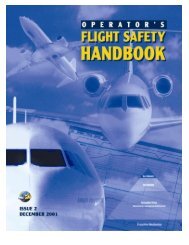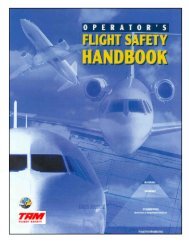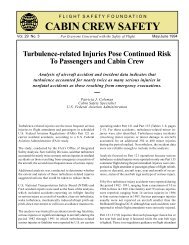Download PDF [10.9 MB] - Flight Safety Foundation
Download PDF [10.9 MB] - Flight Safety Foundation
Download PDF [10.9 MB] - Flight Safety Foundation
Create successful ePaper yourself
Turn your PDF publications into a flip-book with our unique Google optimized e-Paper software.
says. “As with the aeroplane wing, the blade<br />
aerofoil will stall at a critical angle, resulting<br />
in a sudden loss of lift and a large increase<br />
in drag. The increased drag on the blade acts<br />
like a huge rotor brake, causing the rotor rpm<br />
to rapidly decrease, further increasing the<br />
rotor stall.”<br />
The AAIB report noted that in an airplane,<br />
a pilot would react to a stall warning horn by<br />
moving the control column forward to reduce<br />
the wings’ angle-of-attack and adding power.<br />
A similar response in a helicopter, however,<br />
can result in the low-g condition associated<br />
with an uncontrollable right roll and<br />
mast-bumping.<br />
Lightweight Data Recorders<br />
The report noted that Robinson Helicopters<br />
has agreed that additional information is<br />
needed “to fully understand the causes of accidents<br />
involving main rotor divergence.” The<br />
company was considering the installation of a<br />
small lightweight flight data recorder in its aircraft<br />
to help provide more data on pilot control<br />
inputs in the moments preceding a main rotor<br />
divergence, the report said.<br />
“The pilot’s control inputs leading up to the<br />
divergence are rarely known,” the report said.<br />
“If the helicopter manufacturer succeeds in<br />
developing a lightweight flight data recorder for<br />
the R22 that includes recordings of control positions,<br />
it is likely that there will be new insights<br />
into the causes of main rotor divergence.<br />
“The technology already exists to create<br />
a small lightweight recorder that includes<br />
solid-state three-axis gyros, three-axis accelerometers,<br />
GPS [global positioning system]<br />
and an altitude pressure sensor, but one of the<br />
challenges is to develop a lightweight and noninvasive<br />
means of measuring control positions.”<br />
The company also plans research on the<br />
likely effectiveness of combating carburetor<br />
icing by installing a heated throttle butterfly in<br />
the carburetor, the report said.<br />
Other design solutions also could help reduce<br />
the potential for accidents involving loss<br />
of main rotor control, the report said.<br />
FLIGHTSAFETY.ORG | AEROSAFETYWORLD | MAY 2013<br />
“Therefore, the certification requirements<br />
for future helicopter designs should be updated<br />
and improved to reduce the risk of loss of control<br />
and loss of main rotor control accidents,”<br />
the report added. “It is desirable that the EASA<br />
and FAA cooperate in this task.”<br />
This article is based on AAIB Accident Report No. EW/<br />
C2012/01/01, published in the February 2013 “AAIB<br />
Bulletin.”<br />
Note<br />
Robinson R22<br />
1. NTSB. Special Investigation Report — Robinson<br />
Helicopter Company R22 Loss of Main Rotor Control<br />
Accidents, NTSB/SIR-96/03. 1996.<br />
CAUSALFACTORS<br />
The Robinson R22 is a light, two-seat helicopter first flown in 1975.<br />
The R22 Beta was certificated in 1985.<br />
It has a two-blade main rotor with a tri-hinged underslung<br />
rotor head designed to limit blade flexing and rotor vibration, and a<br />
two-blade tail rotor.<br />
The R22 has one 119-kw (160-hp) Textron Lycoming O-320-B2C<br />
piston engine, and a 72.5 L (19.2 gal) fuel tank. The empty weight is<br />
374 kg (824 lb), and maximum takeoff and landing weight is 621 kg<br />
(1,370 lb).<br />
Maximum rate of climb at sea level is 1,200 fpm; maximum level<br />
speed is 97 kt; and range at sea level with auxiliary fuel, maximum<br />
payload and no fuel reserves is 592 km (319 nm).<br />
Source: Jane’s All the World’s Aircraft, U.K. Air Accidents Investigation Branch Report EW/C2012/01/01<br />
© Chris Hallewell/Flickr<br />
| 37


![Download PDF [10.9 MB] - Flight Safety Foundation](https://img.yumpu.com/18550968/39/500x640/download-pdf-109-mb-flight-safety-foundation.jpg)

![Download this Issue [PDF 7 MB] - Flight Safety Foundation](https://img.yumpu.com/18859635/1/190x245/download-this-issue-pdf-7-mb-flight-safety-foundation.jpg?quality=85)

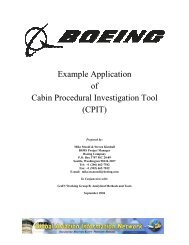
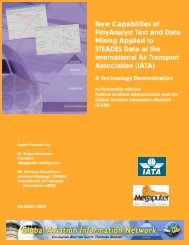
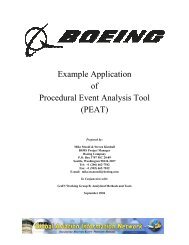

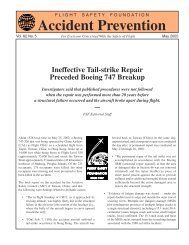
![Download [PDF 8 MB] - Flight Safety Foundation](https://img.yumpu.com/18859366/1/190x245/download-pdf-8-mb-flight-safety-foundation.jpg?quality=85)
